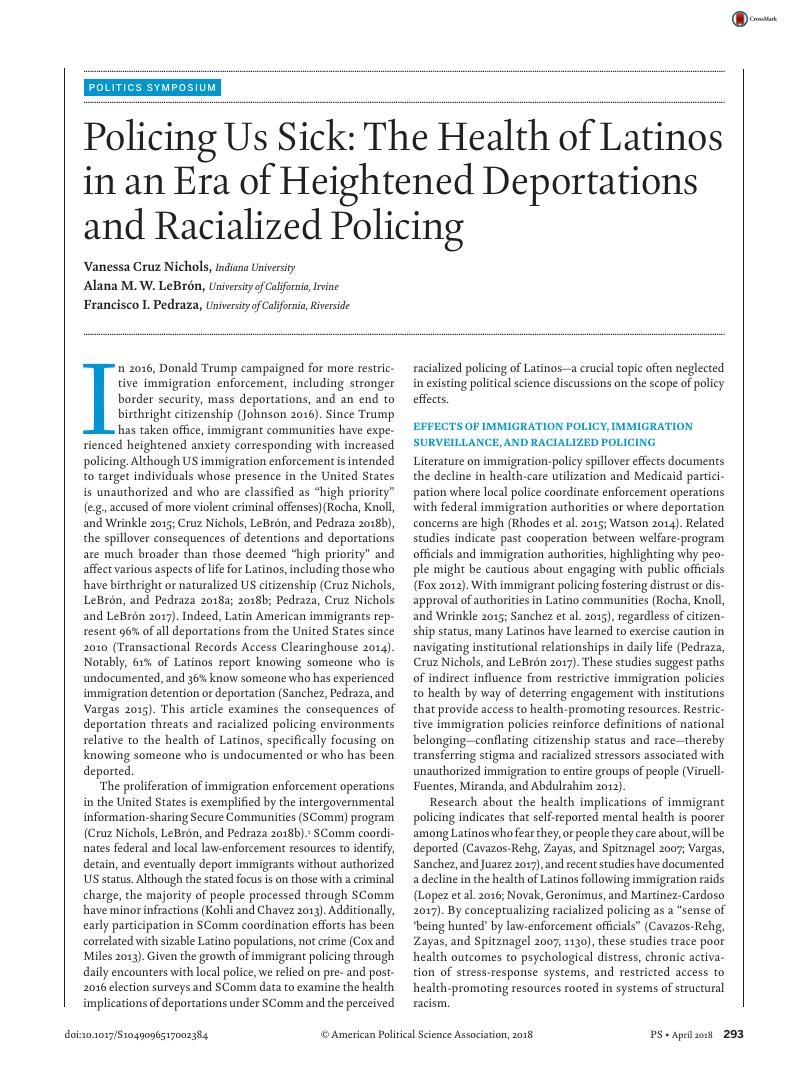Crossref Citations
This article has been cited by the following publications. This list is generated based on data provided by Crossref.
Santiago, Catherine DeCarlo
Distel, Laura M. L.
Ros, Anna M.
Brewer, Stephanie K.
Torres, Stephanie A.
Papadakis, Jaclyn Lennon
Fuller, Anne K.
and
Bustos, Yvita
2018.
Mental Health Among Mexican-Origin Immigrant Families: The Roles of Cumulative Sociodemographic Risk and Immigrant-Related Stress.
Race and Social Problems,
Vol. 10,
Issue. 3,
p.
235.
LeBrón, Alana M. W.
Schulz, Amy J.
Gamboa, Cindy
Reyes, Angela
Viruell-Fuentes, Edna A.
and
Israel, Barbara A.
2018.
“They Are Clipping Our Wings”: Health Implications of Restrictive Immigrant Policies for Mexican-Origin Women in a Northern Border Community.
Race and Social Problems,
Vol. 10,
Issue. 3,
p.
174.
Reny, Tyler
Wilcox-Archuleta, Bryan
and
Cruz Nichols, Vanessa
2018.
Threat, Mobilization, and Latino Voting in the 2018 Election.
The Forum,
Vol. 16,
Issue. 4,
p.
573.
Gemmill, Alison
Catalano, Ralph
Casey, Joan A.
Karasek, Deborah
Alcalá, Héctor E.
Elser, Holly
and
Torres, Jacqueline M.
2019.
Association of Preterm Births Among US Latina Women With the 2016 Presidential Election.
JAMA Network Open,
Vol. 2,
Issue. 7,
p.
e197084.
Perreira, Krista M.
and
Pedroza, Juan M.
2019.
Policies of Exclusion: Implications for the Health of Immigrants and Their Children.
Annual Review of Public Health,
Vol. 40,
Issue. 1,
p.
147.
Fleming, Paul J.
Novak, Nicole L.
and
Lopez, William D.
2019.
U.S. Immigration Law Enforcement Practices and Health Inequities.
American Journal of Preventive Medicine,
Vol. 57,
Issue. 6,
p.
858.
Laird, Jennifer
Santelli, Isaac
Waldfogel, Jane
and
Wimer, Christopher
2019.
Forgoing Food Assistance out of Fear: Simulating the Child Poverty Impact of a Making SNAP a Legal Liability for Immigrants.
Socius: Sociological Research for a Dynamic World,
Vol. 5,
Issue. ,
Edwards, Matthew L.
Saenz, Samuel Ricardo
Collins, Roy
and
Bandstra, Belinda
2020.
Social (In)Justice and Mental Health.
p.
47.
Kiehne, Elizabeth
and
Baca-Atlas, Stefani N.
2020.
Immigration Policy as a Social Determinant of Health: Development and Initial Validation of a Measure to Assess Attitudes toward Immigrant Integration.
Social Work in Public Health,
Vol. 35,
Issue. 5,
p.
293.
Calderon, Maria Apolonia
2020.
Foundations as “Amigos o Rebeldes”: The Influence of Philanthropic Funding on Local Immigration Policy Outputs.
Nonprofit Policy Forum,
Vol. 11,
Issue. 2,
Ramos, Athena K.
Carvajal-Suarez, Marcela
Siahpush, Mohammad
Robbins, Regina
Michaud, Tzeyu L.
Clarke, Martina A.
and
King, Keyonna M.
2020.
Predictors of life satisfaction among Hispanic/Latino immigrants in non-metropolitan communities in the Midwest.
Rural Society,
Vol. 29,
Issue. 2,
p.
75.
Martinez-Cardoso, Aresha
Jang, Woorin
and
Baig, Arshiya A.
2020.
Moving Diabetes Upstream: the Social Determinants of Diabetes Management and Control Among Immigrants in the US.
Current Diabetes Reports,
Vol. 20,
Issue. 10,
Mesa, Hannah
Doshi, Monika
Lopez, William
Bryce, Richard
Rion, Raymond
Rabinowitz, Ellen
and
Fleming, Paul J.
2020.
Impact of anti‐immigrant rhetoric and policies on frontline health and social service providers in Southeast Michigan, U.S.A.
Health & Social Care in the Community,
Vol. 28,
Issue. 6,
p.
2004.
Beccia, Ariel L.
Jesdale, William M.
and
Lapane, Kate L.
2020.
Associations between perceived everyday discrimination, discrimination attributions, and binge eating among Latinas: results from the National Latino and Asian American Study.
Annals of Epidemiology,
Vol. 45,
Issue. ,
p.
32.
Saenz, Samuel Ricardo
2020.
Diverse Patient Populations in Psychiatry: Ethical and Clinical Issues.
Focus,
Vol. 18,
Issue. 1,
p.
52.
Alberto, Cinthya K.
Pintor, Jessie Kemmick
Martínez-Donate, Ana P.
Chen, Jie
and
Ortega, Alexander N.
2020.
Health Care Access and Utilization for Latino Youth in the United States.
Medical Care,
Vol. 58,
Issue. 6,
p.
541.
Marquez, Beatriz Aldana
Marquez-Velarde, Guadalupe
Eason, John M.
and
Aldana, Linda
2021.
Pushing them to the edge: Suicide in immigrant detention centers as a product of organizational failure.
Social Science & Medicine,
Vol. 283,
Issue. ,
p.
114177.
Jones, Bradford S.
Sherman, Jeffrey W.
Rojas, Natalie E.
Hosek, Adrienne
Vannette, David L.
Rocha, Rene R.
García-Ponce, Omar
Pantoja, Maria
and
García-Amador, Jesus Manuel
2021.
Trump-induced anxiety among Latina/os.
Group Processes & Intergroup Relations,
Vol. 24,
Issue. 1,
p.
68.
Morey, Brittany N.
García, San Juanita
Nieri, Tanya
Bruckner, Tim A.
and
Link, Bruce G.
2021.
Symbolic disempowerment and Donald Trump's 2016 presidential election: Mental health responses among Latinx and white populations.
Social Science & Medicine,
Vol. 289,
Issue. ,
p.
114417.
Misra, Supriya
Kwon, Simona C.
Abraído-Lanza, Ana F.
Chebli, Perla
Trinh-Shevrin, Chau
and
Yi, Stella S.
2021.
Structural Racism and Immigrant Health in the United States.
Health Education & Behavior,
Vol. 48,
Issue. 3,
p.
332.



